run flat VOLVO V60 CROSS COUNTRY 2016 Owner´s Manual
[x] Cancel search | Manufacturer: VOLVO, Model Year: 2016, Model line: V60 CROSS COUNTRY, Model: VOLVO V60 CROSS COUNTRY 2016Pages: 402, PDF Size: 10.32 MB
Page 10 of 402
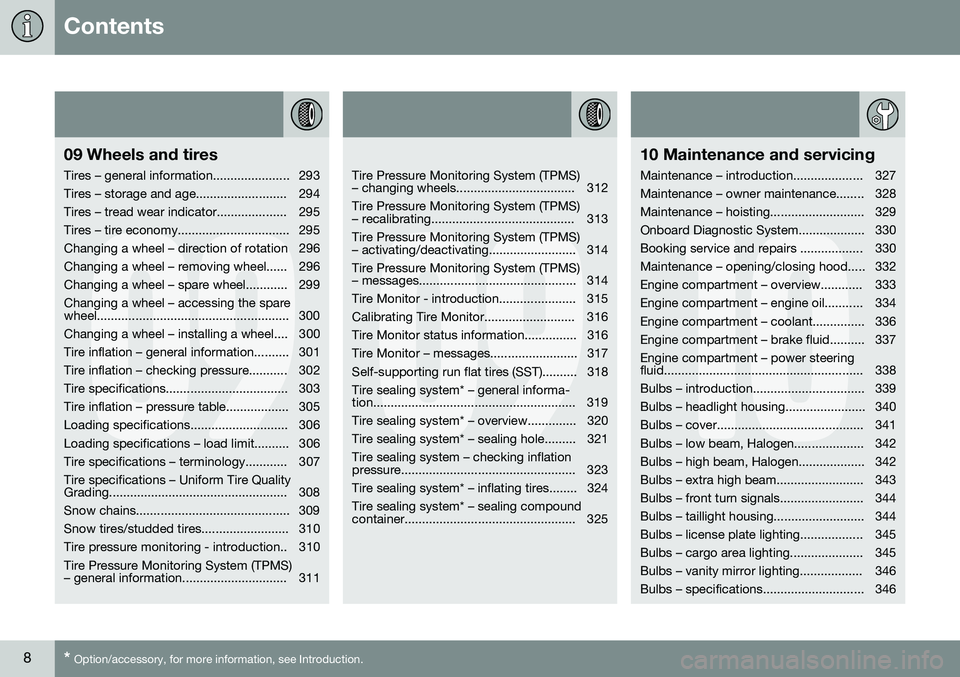
Contents
8* Option/accessory, for more information, see Introduction.
09
09 Wheels and tires
Tires – general information...................... 293
Tires – storage and age.......................... 294
Tires – tread wear indicator.................... 295
Tires – tire economy................................ 295
Changing a wheel – direction of rotation 296
Changing a wheel – removing wheel...... 296
Changing a wheel – spare wheel............ 299Changing a wheel – accessing the spare
wheel....................................................... 300
Changing a wheel – installing a wheel.... 300
Tire inflation – general information.......... 301
Tire inflation – checking pressure........... 302
Tire specifications................................... 303
Tire inflation – pressure table.................. 305
Loading specifications............................ 306
Loading specifications – load limit.......... 306
Tire specifications – terminology............ 307Tire specifications – Uniform Tire Quality
Grading................................................... 308
Snow chains............................................ 309
Snow tires/studded tires......................... 310
Tire pressure monitoring - introduction.. 310Tire Pressure Monitoring System (TPMS)
– general information.............................. 311
09
Tire Pressure Monitoring System (TPMS)
– changing wheels.................................. 312 Tire Pressure Monitoring System (TPMS)
– recalibrating......................................... 313 Tire Pressure Monitoring System (TPMS)
– activating/deactivating......................... 314 Tire Pressure Monitoring System (TPMS)
– messages............................................. 314
Tire Monitor - introduction...................... 315
Calibrating Tire Monitor.......................... 316
Tire Monitor status information............... 316
Tire Monitor – messages......................... 317
Self-supporting run flat tires (SST).......... 318Tire sealing system* – general informa-
tion.......................................................... 319
Tire sealing system* – overview.............. 320
Tire sealing system* – sealing hole......... 321Tire sealing system – checking inflation
pressure.................................................. 323
Tire sealing system* – inflating tires........ 324Tire sealing system* – sealing compound
container................................................. 325
10
10 Maintenance and servicing
Maintenance – introduction.................... 327
Maintenance – owner maintenance........ 328
Maintenance – hoisting........................... 329
Onboard Diagnostic System................... 330
Booking service and repairs .................. 330
Maintenance – opening/closing hood..... 332
Engine compartment – overview............ 333
Engine compartment – engine oil........... 334
Engine compartment – coolant............... 336
Engine compartment – brake fluid.......... 337Engine compartment – power steering
fluid......................................................... 338
Bulbs – introduction................................ 339
Bulbs – headlight housing....................... 340
Bulbs – cover.......................................... 341
Bulbs – low beam, Halogen.................... 342
Bulbs – high beam, Halogen................... 342
Bulbs – extra high beam......................... 343
Bulbs – front turn signals........................ 344
Bulbs – taillight housing.......................... 344
Bulbs – license plate lighting.................. 345
Bulbs – cargo area lighting..................... 345
Bulbs – vanity mirror lighting.................. 346
Bulbs – specifications............................. 346
Page 293 of 402
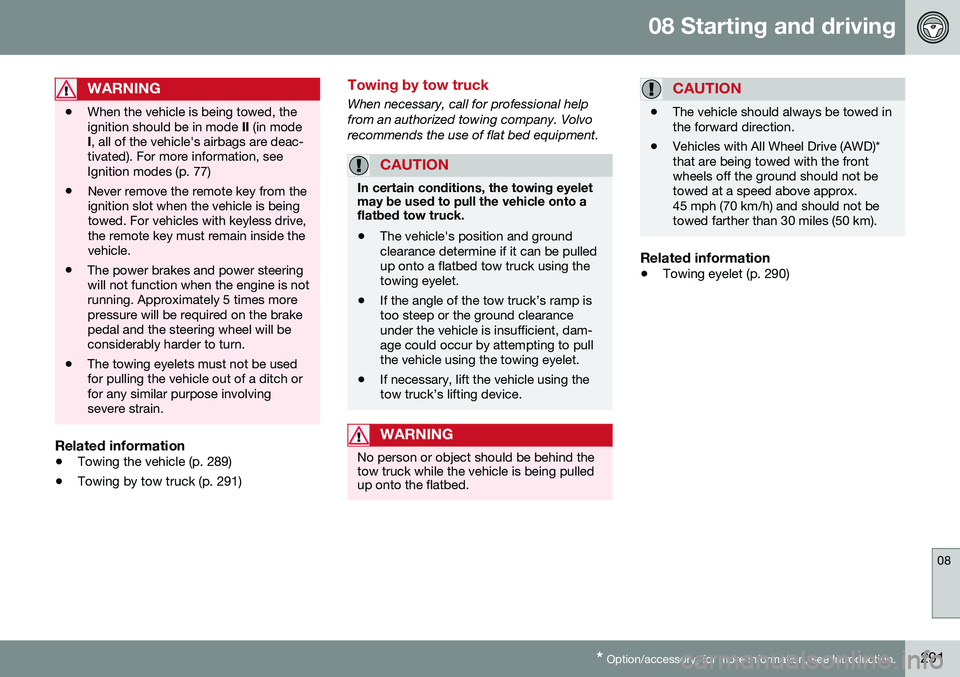
08 Starting and driving
08
* Option/accessory, for more information, see Introduction.291
WARNING
• When the vehicle is being towed, the ignition should be in mode
II (in mode
I , all of the vehicle's airbags are deac-
tivated). For more information, seeIgnition modes (p. 77)
• Never remove the remote key from theignition slot when the vehicle is beingtowed. For vehicles with keyless drive,the remote key must remain inside thevehicle.
• The power brakes and power steeringwill not function when the engine is notrunning. Approximately 5 times morepressure will be required on the brakepedal and the steering wheel will beconsiderably harder to turn.
• The towing eyelets must not be usedfor pulling the vehicle out of a ditch orfor any similar purpose involvingsevere strain.
Related information
•
Towing the vehicle (p. 289)
• Towing by tow truck (p. 291)
Towing by tow truck
When necessary, call for professional help from an authorized towing company. Volvorecommends the use of flat bed equipment.
CAUTION
In certain conditions, the towing eyelet may be used to pull the vehicle onto aflatbed tow truck.
• The vehicle's position and ground clearance determine if it can be pulledup onto a flatbed tow truck using thetowing eyelet.
• If the angle of the tow truck’s ramp istoo steep or the ground clearanceunder the vehicle is insufficient, dam-age could occur by attempting to pullthe vehicle using the towing eyelet.
• If necessary, lift the vehicle using thetow truck’s lifting device.
WARNING
No person or object should be behind the tow truck while the vehicle is being pulledup onto the flatbed.
CAUTION
• The vehicle should always be towed in the forward direction.
• Vehicles with All Wheel Drive (AWD)*that are being towed with the frontwheels off the ground should not betowed at a speed above approx.45 mph (70 km/h) and should not betowed farther than 30 miles (50 km).
Related information
•
Towing eyelet (p. 290)
Page 297 of 402
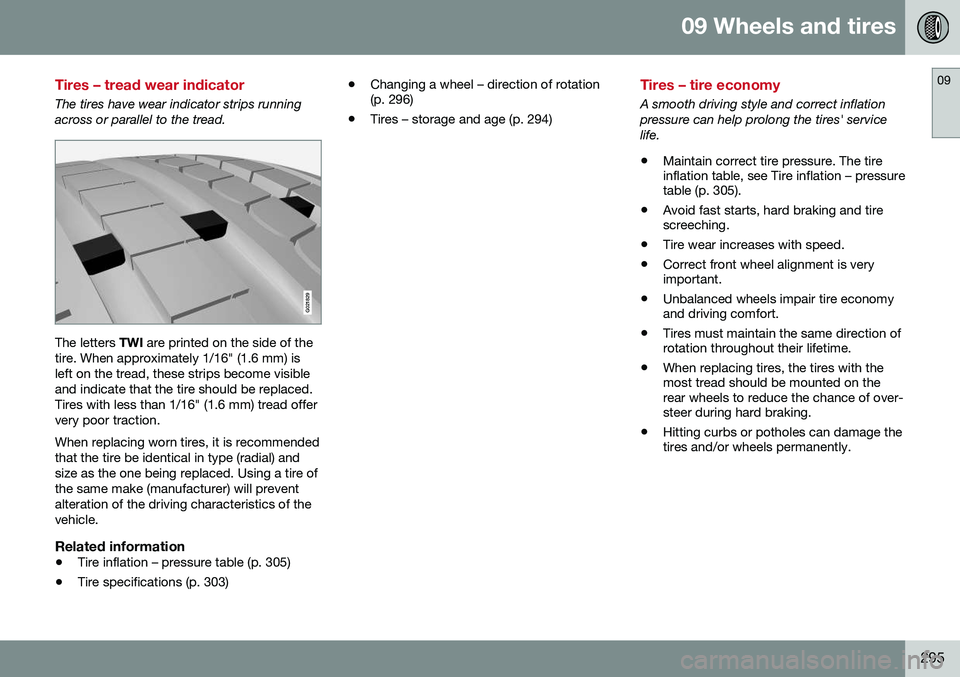
09 Wheels and tires
09
295
Tires – tread wear indicator
The tires have wear indicator strips running across or parallel to the tread.
G021829
The letters TWI are printed on the side of the
tire. When approximately 1/16" (1.6 mm) is left on the tread, these strips become visibleand indicate that the tire should be replaced.Tires with less than 1/16" (1.6 mm) tread offervery poor traction. When replacing worn tires, it is recommended that the tire be identical in type (radial) andsize as the one being replaced. Using a tire ofthe same make (manufacturer) will preventalteration of the driving characteristics of thevehicle.
Related information
• Tire inflation – pressure table (p. 305)
• Tire specifications (p. 303) •
Changing a wheel – direction of rotation (p. 296)
• Tires – storage and age (p. 294)
Tires – tire economy
A smooth driving style and correct inflation pressure can help prolong the tires' servicelife. • Maintain correct tire pressure. The tire inflation table, see Tire inflation – pressuretable (p. 305).
• Avoid fast starts, hard braking and tirescreeching.
• Tire wear increases with speed.
• Correct front wheel alignment is veryimportant.
• Unbalanced wheels impair tire economyand driving comfort.
• Tires must maintain the same direction ofrotation throughout their lifetime.
• When replacing tires, the tires with themost tread should be mounted on therear wheels to reduce the chance of over-steer during hard braking.
• Hitting curbs or potholes can damage thetires and/or wheels permanently.
Page 306 of 402
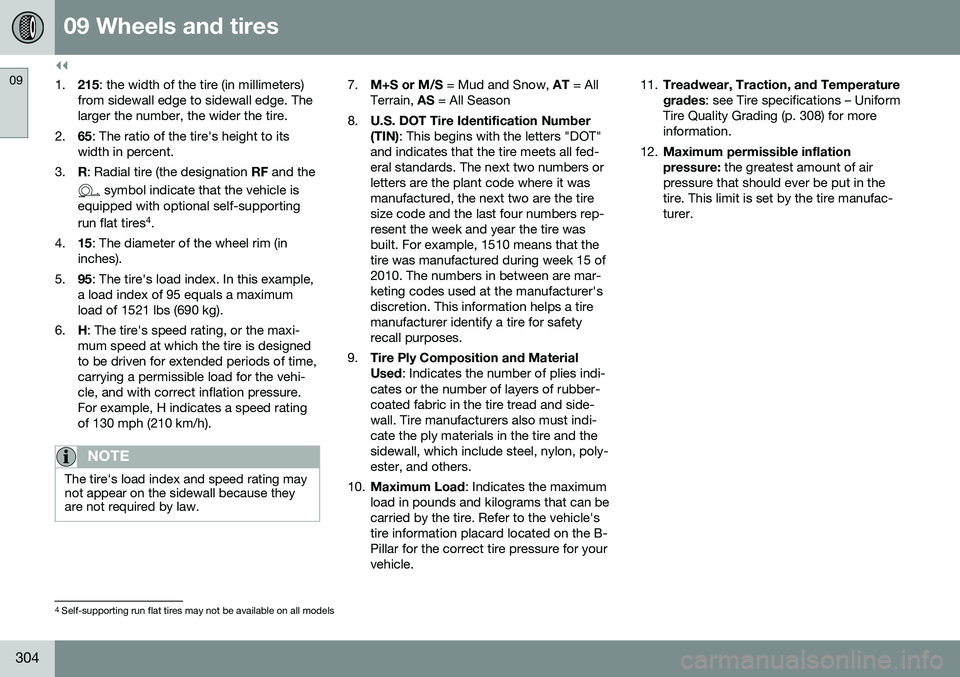
||
09 Wheels and tires
09
304
1.215: the width of the tire (in millimeters)
from sidewall edge to sidewall edge. The larger the number, the wider the tire.
2. 65: The ratio of the tire's height to its
width in percent.
3. R: Radial tire (the designation RF and the
symbol indicate that the vehicle is
equipped with optional self-supporting run flat tires 4
.
4. 15: The diameter of the wheel rim (in
inches).
5. 95: The tire's load index. In this example,
a load index of 95 equals a maximum load of 1521 lbs (690 kg).
6. H: The tire's speed rating, or the maxi-
mum speed at which the tire is designedto be driven for extended periods of time,carrying a permissible load for the vehi-cle, and with correct inflation pressure.For example, H indicates a speed ratingof 130 mph (210 km/h).
NOTE
The tire's load index and speed rating may not appear on the sidewall because theyare not required by law.
7. M+S or M/S = Mud and Snow, AT = All
Terrain, AS = All Season
8. U.S. DOT Tire Identification Number (TIN)
: This begins with the letters "DOT"
and indicates that the tire meets all fed- eral standards. The next two numbers orletters are the plant code where it wasmanufactured, the next two are the tiresize code and the last four numbers rep-resent the week and year the tire wasbuilt. For example, 1510 means that thetire was manufactured during week 15 of2010. The numbers in between are mar-keting codes used at the manufacturer'sdiscretion. This information helps a tiremanufacturer identify a tire for safetyrecall purposes.
9. Tire Ply Composition and Material Used
: Indicates the number of plies indi-
cates or the number of layers of rubber- coated fabric in the tire tread and side-wall. Tire manufacturers also must indi-cate the ply materials in the tire and thesidewall, which include steel, nylon, poly-ester, and others.
10. Maximum Load : Indicates the maximum
load in pounds and kilograms that can becarried by the tire. Refer to the vehicle'stire information placard located on the B-Pillar for the correct tire pressure for yourvehicle. 11.
Treadwear, Traction, and Temperature grades
: see Tire specifications – Uniform
Tire Quality Grading (p. 308) for more information.
12. Maximum permissible inflation pressure:
the greatest amount of air
pressure that should ever be put in the tire. This limit is set by the tire manufac-turer.
4 Self-supporting run flat tires may not be available on all models
Page 312 of 402
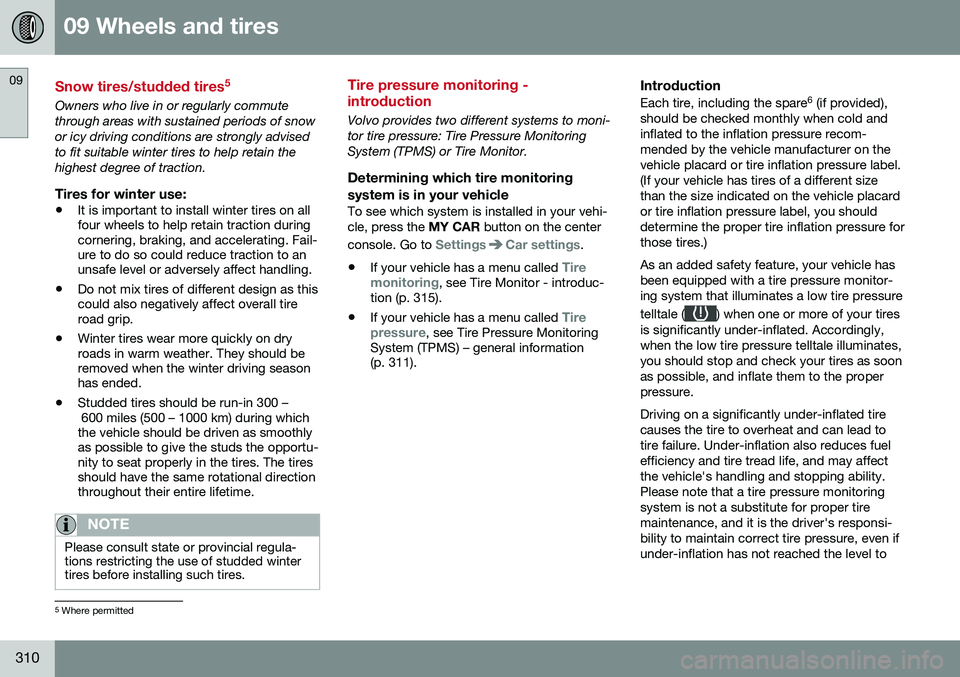
09 Wheels and tires
09
310
Snow tires/studded tires5
Owners who live in or regularly commute through areas with sustained periods of snowor icy driving conditions are strongly advisedto fit suitable winter tires to help retain thehighest degree of traction.
Tires for winter use:
•
It is important to install winter tires on all four wheels to help retain traction duringcornering, braking, and accelerating. Fail-ure to do so could reduce traction to anunsafe level or adversely affect handling.
• Do not mix tires of different design as thiscould also negatively affect overall tireroad grip.
• Winter tires wear more quickly on dryroads in warm weather. They should beremoved when the winter driving seasonhas ended.
• Studded tires should be run-in 300 – 600 miles (500 – 1000 km) during whichthe vehicle should be driven as smoothlyas possible to give the studs the opportu-nity to seat properly in the tires. The tiresshould have the same rotational directionthroughout their entire lifetime.
NOTE
Please consult state or provincial regula- tions restricting the use of studded wintertires before installing such tires.
Tire pressure monitoring - introduction
Volvo provides two different systems to moni- tor tire pressure: Tire Pressure MonitoringSystem (TPMS) or Tire Monitor.
Determining which tire monitoring system is in your vehicle
To see which system is installed in your vehi- cle, press the
MY CAR button on the center
console. Go to
SettingsCar settings.
• If your vehicle has a menu called
Tire
monitoring, see Tire Monitor - introduc-
tion (p. 315).
• If your vehicle has a menu called
Tire
pressure, see Tire Pressure Monitoring
System (TPMS) – general information (p. 311).
Introduction
Each tire, including the spare 6
(if provided),
should be checked monthly when cold and inflated to the inflation pressure recom-mended by the vehicle manufacturer on thevehicle placard or tire inflation pressure label.(If your vehicle has tires of a different sizethan the size indicated on the vehicle placardor tire inflation pressure label, you shoulddetermine the proper tire inflation pressure forthose tires.) As an added safety feature, your vehicle has been equipped with a tire pressure monitor-ing system that illuminates a low tire pressure telltale (
) when one or more of your tires
is significantly under-inflated. Accordingly, when the low tire pressure telltale illuminates,you should stop and check your tires as soonas possible, and inflate them to the properpressure. Driving on a significantly under-inflated tire causes the tire to overheat and can lead totire failure. Under-inflation also reduces fuelefficiency and tire tread life, and may affectthe vehicle's handling and stopping ability.Please note that a tire pressure monitoringsystem is not a substitute for proper tiremaintenance, and it is the driver's responsi-bility to maintain correct tire pressure, even ifunder-inflation has not reached the level to
5 Where permitted
Page 320 of 402
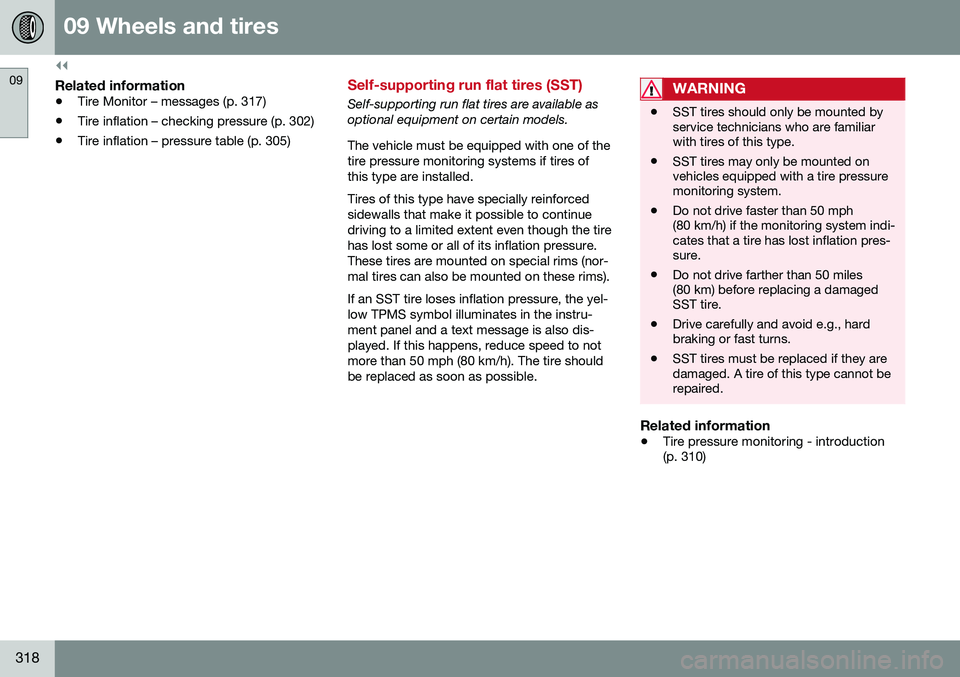
||
09 Wheels and tires
09
318
Related information
•Tire Monitor – messages (p. 317)
• Tire inflation – checking pressure (p. 302)
• Tire inflation – pressure table (p. 305)
Self-supporting run flat tires (SST)
Self-supporting run flat tires are available as optional equipment on certain models. The vehicle must be equipped with one of the tire pressure monitoring systems if tires ofthis type are installed. Tires of this type have specially reinforced sidewalls that make it possible to continuedriving to a limited extent even though the tirehas lost some or all of its inflation pressure.These tires are mounted on special rims (nor-mal tires can also be mounted on these rims). If an SST tire loses inflation pressure, the yel- low TPMS symbol illuminates in the instru-ment panel and a text message is also dis-played. If this happens, reduce speed to notmore than 50 mph (80 km/h). The tire shouldbe replaced as soon as possible.WARNING
•SST tires should only be mounted by service technicians who are familiarwith tires of this type.
• SST tires may only be mounted onvehicles equipped with a tire pressuremonitoring system.
• Do not drive faster than 50 mph(80 km/h) if the monitoring system indi-cates that a tire has lost inflation pres-sure.
• Do not drive farther than 50 miles(80 km) before replacing a damagedSST tire.
• Drive carefully and avoid e.g., hardbraking or fast turns.
• SST tires must be replaced if they aredamaged. A tire of this type cannot berepaired.
Related information
•
Tire pressure monitoring - introduction (p. 310)
Page 324 of 402
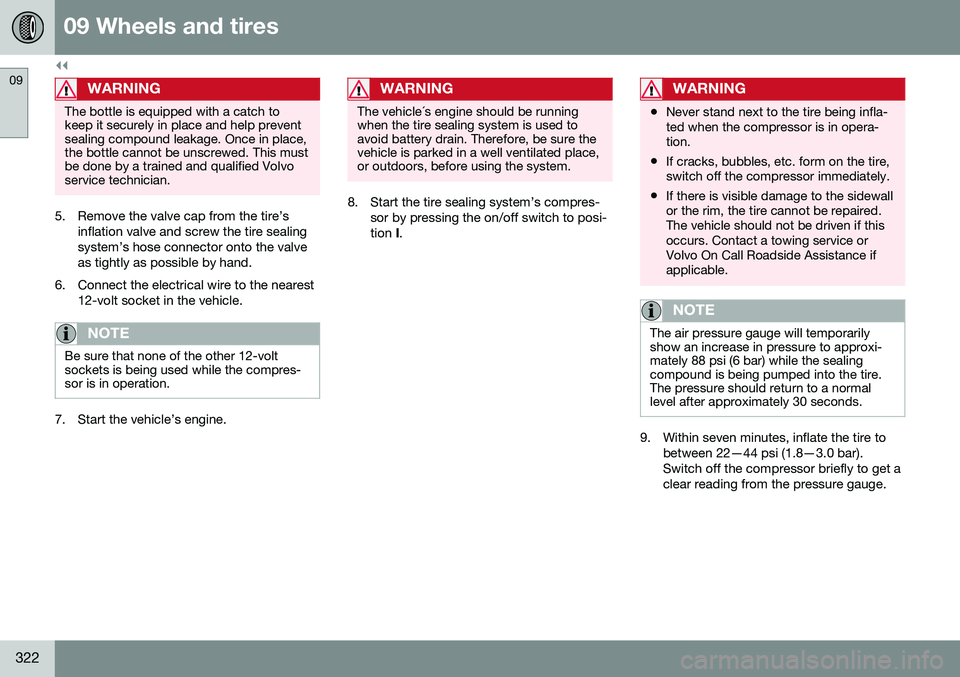
||
09 Wheels and tires
09
322
WARNING
The bottle is equipped with a catch to keep it securely in place and help preventsealing compound leakage. Once in place,the bottle cannot be unscrewed. This mustbe done by a trained and qualified Volvoservice technician.
5. Remove the valve cap from the tire’sinflation valve and screw the tire sealing system’s hose connector onto the valveas tightly as possible by hand.
6. Connect the electrical wire to the nearest 12-volt socket in the vehicle.
NOTE
Be sure that none of the other 12-volt sockets is being used while the compres-sor is in operation.
7. Start the vehicle’s engine.
WARNING
The vehicle´s engine should be running when the tire sealing system is used toavoid battery drain. Therefore, be sure thevehicle is parked in a well ventilated place,or outdoors, before using the system.
8. Start the tire sealing system’s compres-sor by pressing the on/off switch to posi- tion I.
WARNING
• Never stand next to the tire being infla- ted when the compressor is in opera-tion.
• If cracks, bubbles, etc. form on the tire,switch off the compressor immediately.
• If there is visible damage to the sidewallor the rim, the tire cannot be repaired.The vehicle should not be driven if thisoccurs. Contact a towing service orVolvo On Call Roadside Assistance ifapplicable.
NOTE
The air pressure gauge will temporarily show an increase in pressure to approxi-mately 88 psi (6 bar) while the sealingcompound is being pumped into the tire.The pressure should return to a normallevel after approximately 30 seconds.
9. Within seven minutes, inflate the tire to
between 22—44 psi (1.8—3.0 bar). Switch off the compressor briefly to get aclear reading from the pressure gauge.
Page 326 of 402
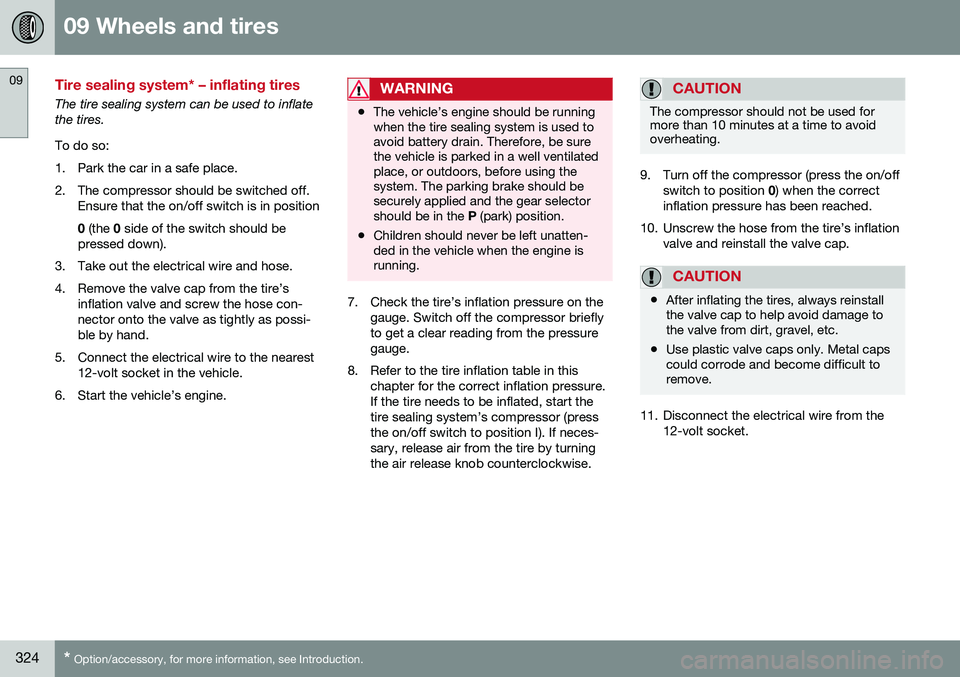
09 Wheels and tires
09
324* Option/accessory, for more information, see Introduction.
Tire sealing system* – inflating tires
The tire sealing system can be used to inflate the tires. To do so:
1. Park the car in a safe place.
2. The compressor should be switched off.
Ensure that the on/off switch is in position0 (the 0 side of the switch should be
pressed down).
3. Take out the electrical wire and hose.
4. Remove the valve cap from the tire’s inflation valve and screw the hose con- nector onto the valve as tightly as possi-ble by hand.
5. Connect the electrical wire to the nearest 12-volt socket in the vehicle.
6. Start the vehicle’s engine.WARNING
• The vehicle’s engine should be running when the tire sealing system is used toavoid battery drain. Therefore, be surethe vehicle is parked in a well ventilatedplace, or outdoors, before using thesystem. The parking brake should besecurely applied and the gear selectorshould be in the
P (park) position.
• Children should never be left unatten-ded in the vehicle when the engine isrunning.
7. Check the tire’s inflation pressure on the
gauge. Switch off the compressor briefly to get a clear reading from the pressuregauge.
8. Refer to the tire inflation table in this chapter for the correct inflation pressure.If the tire needs to be inflated, start thetire sealing system’s compressor (pressthe on/off switch to position I). If neces-sary, release air from the tire by turningthe air release knob counterclockwise.
CAUTION
The compressor should not be used for more than 10 minutes at a time to avoidoverheating.
9. Turn off the compressor (press the on/off switch to position 0) when the correct
inflation pressure has been reached.
10. Unscrew the hose from the tire’s inflation valve and reinstall the valve cap.
CAUTION
•After inflating the tires, always reinstall the valve cap to help avoid damage tothe valve from dirt, gravel, etc.
• Use plastic valve caps only. Metal capscould corrode and become difficult toremove.
11. Disconnect the electrical wire from the
12-volt socket.
Page 394 of 402
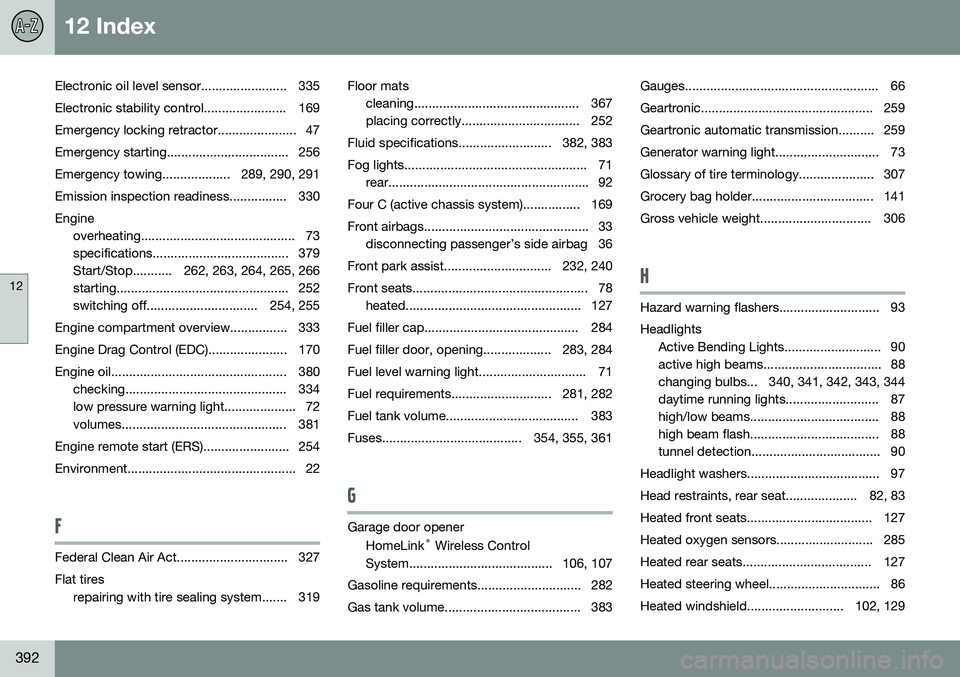
12 Index
12
392
Electronic oil level sensor........................ 335
Electronic stability control....................... 169Emergency locking retractor...................... 47
Emergency starting.................................. 256
Emergency towing................... 289, 290, 291
Emission inspection readiness................ 330Engine overheating........................................... 73
specifications...................................... 379
Start/Stop........... 262, 263, 264, 265, 266
starting................................................ 252
switching off............................... 254, 255
Engine compartment overview................ 333
Engine Drag Control (EDC)...................... 170
Engine oil................................................. 380 checking............................................. 334
low pressure warning light.................... 72
volumes.............................................. 381
Engine remote start (ERS)........................ 254
Environment............................................... 22
F
Federal Clean Air Act............................... 327 Flat tires repairing with tire sealing system....... 319 Floor mats
cleaning.............................................. 367
placing correctly................................. 252
Fluid specifications.......................... 382, 383
Fog lights................................................... 71 rear........................................................ 92
Four C (active chassis system)................ 169
Front airbags.............................................. 33 disconnecting passenger’s side airbag 36
Front park assist.............................. 232, 240
Front seats................................................. 78 heated................................................. 127
Fuel filler cap........................................... 284
Fuel filler door, opening................... 283, 284
Fuel level warning light.............................. 71
Fuel requirements............................ 281, 282
Fuel tank volume..................................... 383
Fuses....................................... 354, 355, 361
G
Garage door opener HomeLink ®
Wireless Control
System........................................ 106, 107
Gasoline requirements............................. 282
Gas tank volume...................................... 383 Gauges...................................................... 66
Geartronic................................................ 259
Geartronic automatic transmission.......... 259
Generator warning light............................. 73
Glossary of tire terminology..................... 307
Grocery bag holder.................................. 141
Gross vehicle weight............................... 306
H
Hazard warning flashers............................ 93 Headlights
Active Bending Lights........................... 90
active high beams................................. 88
changing bulbs... 340, 341, 342, 343, 344
daytime running lights.......................... 87
high/low beams.................................... 88
high beam flash.................................... 88
tunnel detection.................................... 90
Headlight washers..................................... 97
Head restraints, rear seat.................... 82, 83
Heated front seats................................... 127
Heated oxygen sensors........................... 285
Heated rear seats.................................... 127
Heated steering wheel............................... 86
Heated windshield........................... 102, 129
Page 398 of 402
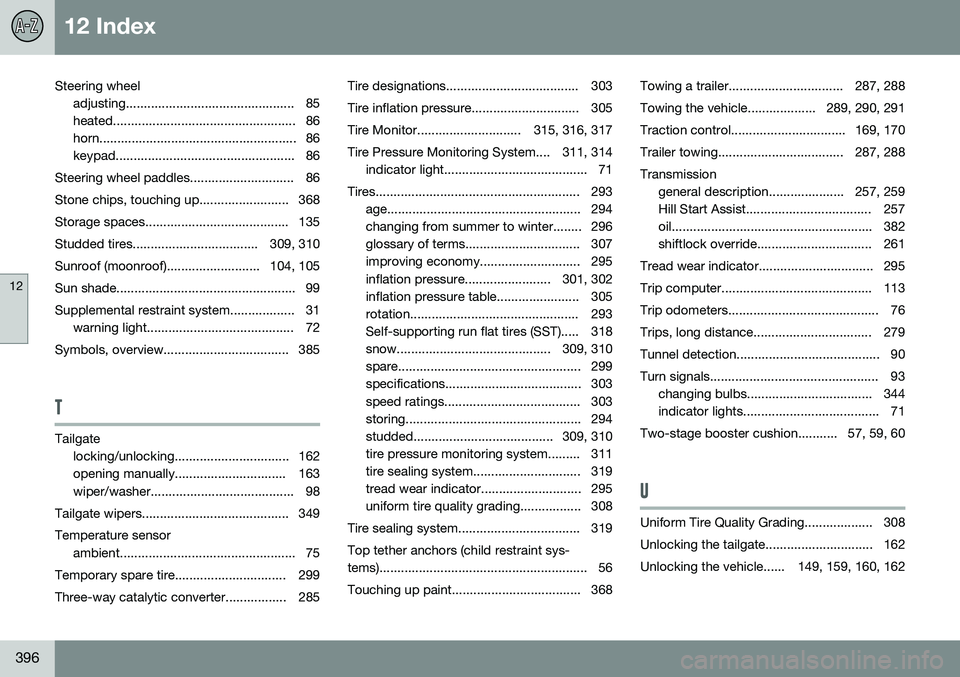
12 Index
12
396
Steering wheeladjusting............................................... 85
heated................................................... 86
horn....................................................... 86
keypad.................................................. 86
Steering wheel paddles............................. 86
Stone chips, touching up......................... 368
Storage spaces........................................ 135
Studded tires................................... 309, 310
Sunroof (moonroof).......................... 104, 105 Sun shade.................................................. 99
Supplemental restraint system.................. 31 warning light......................................... 72
Symbols, overview................................... 385
T
Tailgate locking/unlocking................................ 162
opening manually............................... 163
wiper/washer........................................ 98
Tailgate wipers......................................... 349 Temperature sensor ambient................................................. 75
Temporary spare tire............................... 299
Three-way catalytic converter................. 285 Tire designations..................................... 303
Tire inflation pressure.............................. 305
Tire Monitor............................. 315, 316, 317
Tire Pressure Monitoring System.... 311, 314
indicator light........................................ 71
Tires......................................................... 293 age...................................................... 294
changing from summer to winter........ 296
glossary of terms................................ 307
improving economy............................ 295
inflation pressure........................ 301, 302
inflation pressure table....................... 305
rotation............................................... 293
Self-supporting run flat tires (SST)..... 318
snow........................................... 309, 310
spare................................................... 299
specifications...................................... 303
speed ratings...................................... 303
storing................................................. 294
studded....................................... 309, 310
tire pressure monitoring system......... 311
tire sealing system.............................. 319
tread wear indicator............................ 295
uniform tire quality grading................. 308
Tire sealing system.................................. 319 Top tether anchors (child restraint sys-
tems).......................................................... 56
Touching up paint.................................... 368 Towing a trailer................................ 287, 288
Towing the vehicle................... 289, 290, 291
Traction control................................ 169, 170
Trailer towing................................... 287, 288Transmission
general description..................... 257, 259
Hill Start Assist................................... 257
oil........................................................ 382
shiftlock override................................ 261
Tread wear indicator................................ 295
Trip computer.......................................... 113
Trip odometers.......................................... 76
Trips, long distance................................. 279
Tunnel detection........................................ 90
Turn signals............................................... 93 changing bulbs................................... 344
indicator lights...................................... 71
Two-stage booster cushion........... 57, 59, 60
U
Uniform Tire Quality Grading................... 308
Unlocking the tailgate.............................. 162
Unlocking the vehicle...... 149, 159, 160, 162